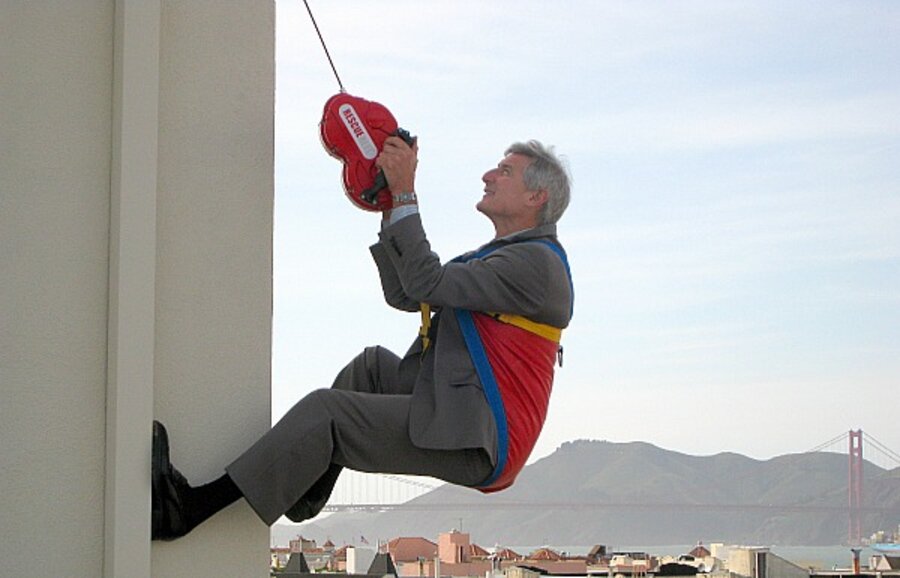One man's 9/11 idea to rescue people from high-rise buildings
Loading...
| New York
On 9/11 Kevin Stone, like most Americans, was horrified as he watched the televised coverage of people jumping out of the upper floors of the World Trade Center to the concrete hundreds of feet below.
But, Dr. Stone, an orthopedic surgeon in San Francisco, remembers thinking, “This is something I ought to be able to solve.”
Now, on the 10th anniversary of the 9/11 attack, Stone thinks he has a product – he calls it Rescue Reel – that would get people safely down from the tops of skyscrapers up to 1,000 feet high.
It involves attaching a harness around your body. Attached to the harness is a Kevlar rope that is secured at one end to a radiator or pipe. You then pop out of a window and rappel down the face of the building using a device which controls the rate of descent at 6 feet per second. Think of it as a fishing reel with a human attached.
“It’s something to use when you have no other choice,” he says.
According to Stone, there are 49,000 fires that take place in high rise buildings each year. The problems of evacuating people from those buildings are multiple: sometimes the fire escapes become smoke-filled; most fire departments only have ladders that reach seven stories; and, if there are people in wheel-chairs, they are told to wait in the fire escape until a fireman can carry them to safety.
“Once you are above seven or eight floors, you are basically out of luck,” says Rick McGee, a battalion fire chief in the San Francisco Bay area. “The hope is that you can work your way up to get people who are trapped out.”
As he worked on his Rescue Reel, Stone found it to be a complex problem. He wanted a device that would hold a 400 pound individual as well as an 80 pound person but move them both at the same speed.
At the same time, it had to move someone from an upper floor of a building to the ground at a good clip – roughly two seconds per floor – so someone would be on the ground in two minutes after fleeing from the sixtieth floor of a building. In addition, the individual could be in a panic so it had to be simple to operate. And, it had to be something that could be adapted for someone in a wheelchair but not be so bulky it would not fit in a file cabinet.
Mr. McGee, who’s familiar with the device, says it could be quite useful, especially since it is a “hands-free” operation – the automatic clutch releases the Kevlar line at a controlled rate of speed. “You could carry a dog, you could carry a disabled person,” says McGee who thinks a smaller version might be adapted for firemen.
After years of development at his own expense, and working in collaboration with Think2Build, a Stanford University-trained engineering team, Stone hired the Rope Works Team, part of the Mistras Group of Reno, Nevada, to test it.
“Depending on the situation it can save lives where people can’t get out,” says Jan Holan, the general manager of the Rope Works Team. “It’s reliable and easy to use.”
However, Mr. Holan thinks anyone who buys the product will want to practice with it by rappelling down a one or two story wall. “It’s not something that you would look at the pictures and go,” he says. “You want to have a chance to use it a few times before an emergency.”
Stone sees the device as a possible marketing tool for a high rise building.
“Take something like the Freedom Tower which is going up in lower Manhattan,” he says. “People might feel more comfortable signing a lease if there were Rescue Reels. There could be whole banks of them next to the fire extinguishers.”
Stone is also hoping that people with disabilities will want their employer to buy one for them if they work in a high rise.
“Right now, if I am disabled, I know I will be the last person rescued in case of a fire,” he says. “But, with the Rescue Reel, I would feel a lot better about being able to get out.”
He also envisions fire departments or mountain rescue units using them to help get injured climbers down from a rocky perch.
“It could help the fire people stay out of trouble,” he explains. “They just drop a Rescue Reel to the person who is hurt.”
In fact, Stone says he has started to receive some orders.
“People are able to put down a deposit,” he says. “We will be confirming manufacturing details in the next few months.”
According to the company's web site, prices range from $2,000 for the model covering a building of 30 floors to $2,700 for 100 floors.





